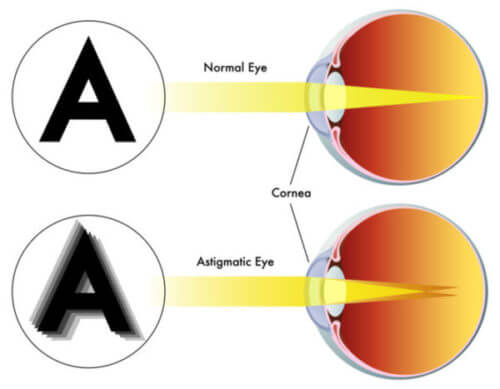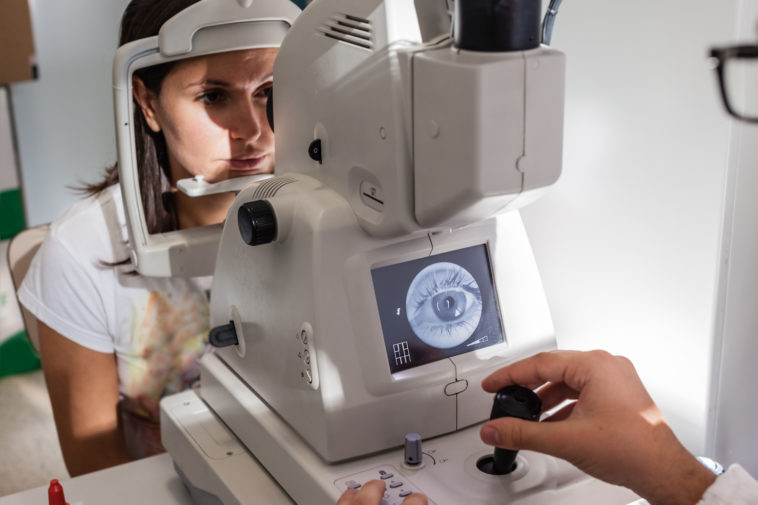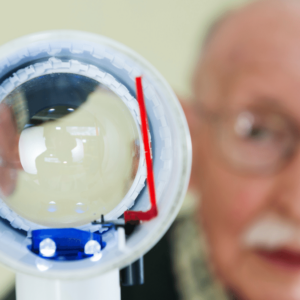What Is Astigmatism?
Astigmatism is a common vision problem that occurs when the cornea and lens of the eye are not evenly curved. It results in blurred vision at any distance and light sensitivity and can even cause headaches, dizziness, or eye strain. Learn more about identifying astigmatism symptoms, getting a proper diagnosis, and potential causes.
Symptoms of Astigmatism
Astigmatism is an eye condition that affects the shape of the cornea and lens, resulting in blurry or distorted vision. This happens when the cornea and lens are not properly curved to refract light evenly. This causes light to be focused on multiple points instead of one, resulting in blurred vision at any distance. People with astigmatism often experience light sensitivity, headaches, dizziness, and eye strain from trying to focus.
The most common symptoms of astigmatism include:
- Blurred or distorted vision at all distances
- Eyestrain or headaches
- Squinting to try to see more clearly
- Difficulty with night vision
- Glare or halos around lights
- Double vision in one eye
It’s worth noting that some people with astigmatism may not experience any symptoms or notice their symptoms until they are diagnosed with the condition. If you suspect you may have astigmatism, it’s essential to schedule an eye exam with an optometrist or ophthalmologist.
Diagnosing Astigmatism
Astigmatism is typically diagnosed during a comprehensive eye exam. Your eye doctor will use a variety of tests to determine if you have the condition and its severity.
The first is a visual acuity test, which measures how well you can see at different distances. This test is done with and without corrective lenses to see how well they correct your vision.
Next, the doctor will use a keratometer device to measure the curvature of your cornea. The keratometer projects a circle of light onto your cornea and then measures the reflection to determine the cornea’s shape.
Another test is called a refraction test, performed by using a phoropter. This test measures the amount of lens power needed to correct your vision.
Finally, the doctor may use a biomicroscope, also known as a slit-lamp, to examine the front of your eye and look for any signs of damage or disease.
Based on the results of these tests, your eye doctor can diagnose whether you have astigmatism and determine the treatment for you.
Potential Causes of Astigmatism

Astigmatism is an eye condition where the cornea, or the outer curved surface of the eye, has an uneven shape. The primary causes of astigmatism are:
- Genetics: Astigmatism tends to run in families, and certain genetic conditions, such as keratoconus, can increase the risk of developing the condition.
- Eye injury or surgery: Trauma or surgery to the eye can cause the cornea or lens to become misshapen, leading to astigmatism.
- Congenital: Some babies are born with astigmatism caused by an irregularly shaped cornea or lens.
- Disease: Certain diseases, such as rheumatoid arthritis or diabetes, can increase the risk of developing astigmatism.
- Aging: As we age, the shape of the lens inside the eye can change, leading to astigmatism.
It’s worth noting that in some cases, the cause of astigmatism may not be clear.
Astigmatism in Children
Astigmatism can occur in children, just as it can in adults. Children with astigmatism may experience symptoms such as blurred vision, eyestrain, or difficulty with activities that require good visual acuity, such as reading or playing sports. They may also squint or tilt their head to try to see more clearly.
Astigmatism can be congenital, meaning that a child is born with the condition or can develop later in childhood. Sometimes it may be difficult for parents to detect astigmatism in their child, as the child may not know that their vision is blurry or distorted. It’s essential to have a child’s eyes checked by an optometrist or ophthalmologist at regular intervals, especially if there is a family history of eye problems.
Astigmatism is often treated with eyeglasses, contact lenses, or refractive surgery. Children diagnosed with astigmatism can seek the same treatment options that adults do.
It’s important to note that children’s eyes continue to develop and change throughout childhood, so they may need to have their eyeglasses or contact lenses adjusted or replaced as they grow.
Types of Astigmatism
There are three main types of astigmatism:
- Myopic Astigmatism: This type of astigmatism is characterized by a cornea that is more curved in one direction than the other. It results in blurred vision for both near and far objects.
- Hyperopic Astigmatism: Also known as hypermetropic astigmatism, this type of astigmatism is characterized by a cornea that is flatter in one direction than the other. It results in blurred vision for near objects and is often associated with farsightedness.
- Mixed Astigmatism: This type of astigmatism combines myopic and hyperopic astigmatism and results in blurred vision for both near and far objects.
Astigmatism can be classified as regular or irregular.
Regular Astigmatism: this is the most common type of astigmatism and occurs due to a symmetrical irregularity in either the shape of the cornea or lens. This irregularity can be a flat or steep curve, which distorts vision, making it blurry or distorted. Fortunately, regular astigmatism can be corrected with glasses or contact lenses.
Irregular Astigmatism: is a type of vision-related disorder caused by an irregular and non-symmetrical shape of the cornea or lens. It occurs as a result of diseases, trauma, or surgery. Examples include keratoconus – where the cornea becomes thinned out and bulged forward – and post-surgical astigmatism that might occur after certain eye operations. Irregular astigmatism is trickier to treat than regular astigmatism and might need more customized approaches, such as custom contact lenses or corneal refractive therapy.
It’s important to note that the severity of Astigmatism can vary from person to person, and an eye doctor can help determine the type and severity of Astigmatism during an eye examination.
Treatments for Astigmatism
There are several treatment options available for astigmatism, including:
- Eyeglasses: are corrective lenses worn to improve the vision of people with refractive errors such as nearsightedness, farsightedness, and astigmatism. Toric lenses are a particular type of lens used for astigmatic patients, and they help to bend the light entering the eye in a way that offsets the irregularity of its shape. Eyeglasses are of great use for those with astigmatism who need clear sight.
Prescriptive lenses can help correct regular astigmatism to 20/20, while irregular astigmatism often cannot be corrected to regular sight. The American Academy of Ophthalmology states that regular astigmatism can be improved to 20/20.
- Contact lenses are a great alternative to eyeglasses for correcting astigmatism. They offer the same level of correction as eyeglasses while being non-intrusive and providing improved sight. Various contact lenses are available, such as soft toric, rigid gas permeable (RGP), and hybrid lenses.
- Refractive surgery: Refractive surgery is a procedure used to correct astigmatism; it involves reshaping the cornea using an advanced surgical technique such as laser-assisted in situ keratomileusis (LASIK) or photorefractive keratectomy (PRK).
- Orthokeratology: This is an innovative, non-surgical approach to correct astigmatism. This process involves wearing special contact lenses while you sleep—you must remove them during the day. The lenses are designed to reshape the cornea overnight so that when you wake up, your vision is improved.
The treatment for astigmatism can vary depending on the severity of the condition and other factors such as overall eye health and lifestyle needs. An eye doctor can help assess the best treatment option for you based on your individual needs and preferences.
Who are At The Risk of Astigmatism?
Astigmatism is a common eye condition where the cornea or lens of the eye is irregularly shaped, causing blurred or distorted vision. Anyone can develop astigmatism, but certain groups of people may be at a higher risk, including:
- People with a family history of astigmatism
- People with certain other eye conditions, such as nearsightedness or farsightedness
- People who have had an eye injury or surgery
- People with certain medical conditions, such as keratoconus, can be more prone to developing astigmatism.
It’s important to note that a regular eye exam is essential to detect any vision problem.
Astigmatism Surgery
Astigmatism is an eye condition characterized by an irregularly shaped cornea that causes blurred vision. Surgery may be recommended in severe cases to correct the condition. This type of surgery, known as astigmatism surgery, can reshape the cornea to reduce or eliminate the blurriness caused by astigmatism.
Different techniques and procedures may be used depending on the severity of the patient’s condition, including:
- Laser-assisted in situ keratomileusis (LASIK): is a type of laser eye surgery used to correct astigmatism. The procedure involves reshaping the cornea with an IntraLase laser, allowing light entering the eye to be focused more precisely on the retina for better vision.
- PRK, or Photorefractive keratectomy, is a type of laser eye surgery that reshapes the cornea to correct astigmatism. It is often used to correct nearsightedness, farsightedness, and astigmatism. Unlike other laser vision correction procedures, such as LASIK, PRK does not require the creation of a corneal flap. Instead, a small area of the cornea’s surface is removed before reshaping it with an excimer laser.
- Astigmatic keratotomy (AK) is a surgical procedure used to correct astigmatism. It involves making incisions in the cornea with specialized instruments, which reshape it to reduce or eliminate astigmatism. The procedure is simple and outpatient, and most patients experience good results with minimal discomfort.
- Conductive Keratoplasty, or CK, is a surgical procedure to help reshape the cornea. It involves a tiny device that releases radiofrequency energy applied to specific parts of the cornea, which causes it to contract, changing its shape. The technology involved in this technique represents a major leap forward for vision correction.
These procedures are typically done on an outpatient basis, and most people will be able to return to their activities within a few days.
You must consult an ophthalmologist to determine which treatment is right for you. All surgeries come with certain risks, so it’s important to discuss any procedure’s potential risks and benefits before making a decision.
Summary
Astigmatism is a vision impairment where the eye doesn’t focus light evenly on the retina.
People with astigmatism often have blurred vision at all distances and may experience eyestrain, headaches, and difficulty reading.
To achieve a clearly-focused vision, individuals with astigmatism must choose eyeglasses or contact lenses specially designed to correct their unique vision issue. Surgery may also be an option for some cases – but only after research and consultation with your eye doctor.






